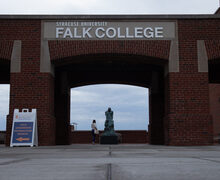Center for Policy Research discusses Micron’s economic, environmental impacts
Malcolm Taylor | Staff Photographer
The panel — titled “Micron in Central New York: What’s at Stake for the Local Environment, Amenities and Infrastructure?” — was moderated by Rebecca Schewe, an associate professor in Syracuse University's Sociology Department.
Get the latest Syracuse news delivered right to your inbox.
Subscribe to our newsletter here.
Syracuse University’s Center for Policy Research at the Maxwell School of Citizenship and Public Affairs hosted a virtual panel discussion Monday afternoon to address the economic and environmental implications of Micron’s investment in the central New York region.
Over 150 attendees attended the discussion to hear insight from Maxwell faculty and CPR senior research associates about the future economic changes Micron’s investment may bring to the area. The panelists also addressed concerns with sustainability efforts, access to economic opportunity for county residents and public infrastructure.
Yilin Hou, a professor in the Public Administration and International Affairs Department, emphasized the need for Micron and local leaders to balance the anticipated transformation of the regional economy with investments in public infrastructure and a commitment to sustainability efforts.
“New York State and central New York possess all the makings for another round of glory and prosperity, but to turn it into reality, there are many tasks that we must accomplish and do well,” Hou said. “Micron’s commitment has to be matched from our side with inventiveness by state and local governance, as well as the endorsement and hard work of all central New Yorkers.”
The panel — titled “Micron in Central New York: What’s at Stake for the Local Environment, Amenities and Infrastructure?” — was moderated by Rebecca Schewe, an associate professor in the Sociology Department. Each panelist gave introductory remarks, followed by a question and answer session.
Hou and Carmen Carrión-Flores, a research assistant professor in the Economics Department, pointed to past examples of how large manufacturing efforts devastated the local environment. Each mentioned the high levels of mercury pollution in Onondaga Lake caused by the Allied Chemical and Die Company decades ago.
“It is not the first time that central New York has faced trade-offs between economic growth and the quality and protection of environmental amenities,” Carrión-Flores said.

Sierra Zaccagnino | Digital Design Editor
Carrión-Flores said Micron should be transparent about its planned sustainability strategies, which she added should encompass responsibly managing water, improving energy efficiency and using materials and processes that are not harmful to the environment.
As part of its commitment to sustainability, Micron’s current goals include using 100% renewable electricity and achieving 100% water reuse, recycling and restoration in its coming operations.
The panelists also discussed how Micron’s investment could be impacted by the Interstate 81 viaduct project, a $2.25 billion effort to replace portions of the highway with a community grid.
Alexander Rothenberg, an assistant professor in the Economics Department, said the I-81 highway project can help reverse the long-standing racial inequities and environmental disparities caused by the highway’s construction, but could pose logistical challenges for commuters.
For downtown residents in communities like the South Side, driving out of the city to the new Micron plant in Clay could be difficult because of the highway project’s traffic diversions, Rothenberg said. As part of the project, construction will occur at portions of Interstate 481 and 690 to accommodate for the change in traffic.
Despite all the changes, Rothenberg said the city of Syracuse will eventually adjust to the new economy.
“My hope is that Micron’s increased demand for labor … will offset the added cost of density and additional environmental costs, and after a period of adjustment, residents will be, on average, better off,” Rothenberg said. “But I think it’s important to keep in mind that there are some very complex issues of equity and efficiency that are just difficult to ascertain and deserve further scrutiny.”
While environmental and infrastructural questions remain, Rothenberg noted the magnitude of Micron’s investment in the region. With approximately 310,000 workers in the Syracuse area, Rothenberg said the jobs Micron is promising could increase employment opportunities by 16% and raise the number of jobs in the Syracuse market to its highest level in over 30 years. The new plant is expected to bring 50,000 jobs to the CNY region with its long-term investment.
Hou emphasized how the long-term investment gives the community the leeway for changes to be implemented over time and avoid the county’s past shortcomings with sustainability efforts.
“Do not repeat the same mistakes. Apply high standards, (and) develop a high tech economy while preserving our environment for the long future — water, forest, soil and the overall landscape of Central New York,” Hou said.
Published on November 6, 2023 at 10:50 pm
Contact Dominic: [email protected] | @DominicChiappo2





